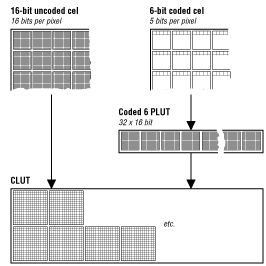User Tools
Table of Contents
Fundamentals of 3DO Graphics
In this background section you learn about:
For More Information
The 3DO Graphics Programmer's Guide provides a comprehensive discussion of 3DO graphics programming, supplemented by function descriptions for all functions in the 3DO Graphics Programmer's Reference.
The volume 3DO Tools for Art Production contains manuals for all 3DO art conversion tools and the Introduction to 3DO Graphics manual, which is aimed at graphic artists but is useful for a more general audience as well.
3DO Cels and Images
The two basic formats for 3DO graphics are 3DO images and 3DO cels.
- A 3DO image is the simplest kind of 3DO graphic. For NTSC screens, it is a 320-x-240 array of 16-bit pixel values, laid out in the format of the display buffer (352 x 288 for PAL). The hardware can draw an image very quickly by copying it into the display buffer directly, but cannot process or compress images. jsbasicslideshow.c displays images in sequence based on user input. It's also possible to let the slide show run in stand-alone mode.
- A 3DO cel is more complex than an image. In addition to the raw pixel data, a cel has a header called a cel control block (CCB) that tells the cel engine how to draw the cel. A program can flip, rotate, stretch, or even “bow-tie” the cel as it is being displayed. You can also make parts of the cel transparent or translucent, or you can enhance its luminance, if the illustration has been prepared correctly using the 3DO PostPro tool, a Photoshop custom plug-in, or the 3DO Animator tool. Most of the Jumpstart2 example programs use cels.
There are several cel formats. The format depends on the number of bits per pixel and on whether the cel is indexed into a color table (coded) or not.
Note: 3DO animations consist of 3DO cels, and are discussed in Playing an Animation.
Uncoded and Coded Cels
Uncoded cels contain pixels with values that are turned directly into 16-bit frame-pixel values. Uncoded cels offer a large number of colors but use more memory than coded cels.
Coded cels are indexed into a color table. As a result, coded cels end up being much smaller than uncoded cels, as illustrated below.
Figure 1: How uncoded and coded cels use the system color table.
The color table is part of a pixel lookup table (PLUT). The PLUT contains the color table and may also contain extra bits to store information about how the pixel is displayed. A pixel may become partly transparent, may have its color enhanced by an alternate multiply value (AMV), or may be mixed with the background using a P-Mode setting. P-Mode (or Pixel-Mode) lets you change the display for predefined pixels or predefined colors. You can use P-Mode, for example, to make part of a cel translucent and part of a cel opaque, or to make part of a cel smoky or enhance its brightness.
Commonly Used Cel Formats
Commonly used cel formats are 16-bit uncoded cels 8-bit or 6-bit coded cels:
- 16-bit uncoded cels store a full 15-bit RGB value for each pixel, allowing the cel to use the full range of display colors. Because each pixel takes up 2 bytes, these cels take twice as long to render as cels that use 8 or fewer bits per pixel. The topmost bit in a 16-bit uncoded cel is used for P-Mode.
- 8-bit coded cels provide 32 colors and 7 additional shades of each color. They don't use much more space than 6-bit coded cels but provide far more colors. You can use the Coded-8 CelWriter, discussed in the 3DO Custom Plug-Ins and CCMs manual in the volume “3DO Tools for Art Production,” to create 8-bit coded cels.
- 6-bit coded cels have only 32 colors. Each pixel is stored as a 5-bit index into a palette of 32 colors. The palette is user-definable, and can be unique to one cel or shared among many cels. The topmost bit in a 6-bit coded cel is used for P-Mode, just like the topmost bit in a 16-bit uncoded cel.
3DO developers don't often use 8-bit uncoded cels, since they offer only 256 colors and color distortion during cel creation can be quite noticeable.

